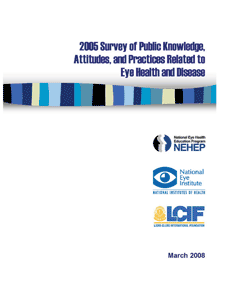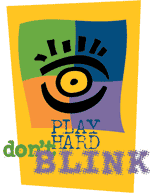Educational Resource Spotlight: Children's Eye Safety Calendar
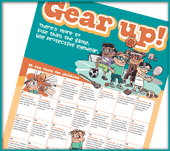
Order the Calendar
Order Other Materials
Healthy Vision Community Programs Database
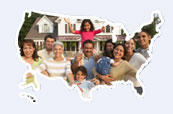
This easy-to-search resource can help you learn about new ways to address eye health issues and replicate eye health-related projects in your community.
In This Issue:

Letter from the Chair of the NEHEP Planning Committee
The National Eye Health Education Program (NEHEP) works to educate the public with evidence-based information about eye health and the importance of early detection and timely treatment in minimizing vision loss. In this issue of Outlook, you’ll learn about findings from a national survey on knowledge, attitudes, and practices related to eye health and disease. Findings from the survey support the need for NEHEP and others interested in eye health to continue educating the public about preventable vision loss due to disease or injury. To learn more about the findings and where to access the full report, read “NEI Releases Findings from Survey on Public Knowledge, Attitudes, and Practices Related to Eye Health and Disease.”
One of the ways NEHEP strives to educate the Nation is through programs and initiatives like Healthy Vision Month and the Healthy Vision Community Awards Program.
Healthy Vision Month has been held each May since 2003. This year we are encouraging parents, coaches, and eye care professionals to support children in using protective eyewear during sports-related activities. Thousands of children suffer permanent, senseless vision loss every year by playing sports without protecting their eyes. We encourage you to support Healthy Vision Month by becoming involved in activities to educate your community about this important issue. The “Kids Need to Gear Up for Eye Safety” article provides some ideas about how you can do this. Read the “Community Awardee Spotlight” article to learn how one organization is educating parents, coaches, and children about protective eyewear in the state of Ohio.
Implementing eye health and vision care at the community level is a key component in working toward healthy vision for everyone. To encourage these important efforts, the National Eye Institute (NEI) established the Healthy Vision Community Awards Program to provide seed money to nonprofit, community-based organizations to develop eye health education projects. Read “Community-based Organizations May Be Eligible for NEI Awards” to find when applications will be available.
The last item in this issue that I’d like to highlight is the Health Resources and Services Administration’s new online resource to help enhance patient-centered health communication skills. The course addresses health literacy, cultural competency, and limited English proficiency. It’s free, can be taken at your own pace, and you can receive continuing education credit.
I hope you enjoy this issue of Outlook! If you have any comments or suggestions to help shape future issues, let us know. We’d like to hear about your eye health efforts and how you have promoted NEHEP messages and used NEHEP materials. Please forward Outlook to others interested in making vision a health priority.
Eve Higginbotham, M.D.
Chair, National Eye Health Education Program Planning Committee
Dean and Senior Vice President of Academic Affairs
Morehouse School of Medicine
Atlanta, GA
NEI Releases Findings from Survey on Public Knowledge, Attitudes, and Practices Related to Eye Health and Disease
Most Americans don’t know the risks and warning signs of diseases that could blind them if they don’t seek timely detection and treatment, according to recent findings of the Survey of Public Knowledge, Attitudes, and Practices Related to Eye Health and Disease. This survey was sponsored by the National Eye Institute (NEI) and Lions Clubs International Foundation (LCIF).
Seventy-one percent of respondents reported that a loss of their eyesight would rate as a 10 on a scale of 1 to 10, meaning that it would have the greatest impact on their day-to-day life. However, only 8 percent knew that there are no early warning signs of glaucoma, a condition that can damage the eye’s optic nerve and result in vision loss and blindness.
Fifty-one percent said that they have heard that people with diabetes are at increased risk of developing eye disease, but only 11 percent knew that there are usually no early warning signs. Only 16 percent had ever heard the term “low vision,” a condition that affects millions of Americans. Low vision is vision loss that standard eyeglasses, contact lenses, medicine, or surgery cannot correct, making everyday tasks difficult to do. Simple tasks like reading the mail, watching TV, shopping, cooking, and writing become challenging.
Hispanic respondents reported the lowest access to eye health information, knew the least about eye health, and were the least likely to have their eyes examined among all racial/ethnic groups participating in the survey. Forty-one percent of Hispanics reported that they had not seen or heard anything about eye health or disease in the last year, compared with 28 percent of Asians, 26 percent of African Americans, and 16 percent of Caucasians.
More than 3,000 adults were selected randomly to participate in this national telephone survey conducted between October 2005 and January 2006. The findings reinforce the critical need to educate the public about common eye diseases, such as glaucoma, diabetic eye disease, and age-related macular degeneration.
“Good eyesight is important to our quality of life and it is essential for adults to have accurate information to help them make informed decisions about their eye health needs,” said Paul A. Sieving, M.D., Ph.D., director of NEI, “These survey results will help us identify specific ways in which we can close the gap in knowledge about eye diseases and address the disparities that exist.”
NEI plans to use the survey results to develop ways to raise public awareness of eye disease and the importance of early detection and treatment. NEI will also expand its educational outreach to Hispanics.
In addition to these actions, NEI will increase its efforts to educate health care providers on how to communicate with patients about ways to preserve and protect their vision. “The survey shows us that nearly one-quarter of Americans have not seen or heard anything about eye health or disease, and yet more than 90 percent have seen a health care provider,” Sieving said, “We need to educate these doctors, nurses, and other health care professionals with the tools they need to educate their patients on how to better maintain their eye health.”
“Lions have long been champions of people who are blind and visually impaired. By better educating the public on the need for regular eye exams and timely treatment of eye diseases, we can end preventable blindness,” said Jimmy Ross, Chairperson, LCIF.
For the full report, visit: http://www.nei.nih.gov/kap/.Kids Need to Gear Up for Eye Safety
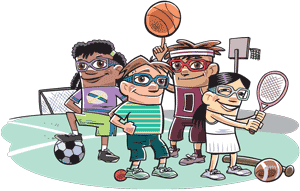
May is Healthy Vision Month! This year the focus is on the need for children to safeguard their eyes by using protective eyewear while playing sports. Ninety percent of sports-related eye injuries can be prevented with the use of protective eyewear.1 We want kids and those who care about them to know how important it is to gear up and use protective eyewear because there’s more to lose than just the game.
There is a lot you can do to help prevent needless sports-related eye injuries. Please join NEI in getting the word out about the importance of protective eyewear. Visit the Healthy Vision Month Website for more information and free resources you can use to educate children, parents, and coaches in your community. The following are examples of materials you will find and ideas about how to use them.
Sports-Related
Eye Injury Facts
Eye injuries are the leading cause of blindness in children in the United States and most eye injuries to school-aged children are sports-related.2
Every 13 minutes a sports-related eye injury is treated in an emergency room in the United States.3
The majority of these eye injuries occur in children under the age of 15.4
Children’s Eye Safety Calendar: Children will enjoy reading this fun, colorful calendar that provides 31 facts about eyes and eye injuries, as well as sports trivia. It is a great way to teach school-aged children about sports-related eye injuries and the need for protective eyewear. Distribute it in schools, at before- and aftercare centers, to youth sports leagues, or at community events.
Drop-In Articles: Educate your community about how protective eyewear can help prevent most sports-related eye injuries. There is an article for kids and one for adults. You can send the articles to your local newspaper and ask local sports clubs, organizations that serve kids, and recreation centers to post it on their websites or insert it in their newsletters.
PowerPoint Presentation and Speaker’s Guide: Inform parents, teachers, and coaches about how frequently sports-related eye injuries occur and how using protective eyewear can prevent most of them. Contact your local youth sports organizations or the parent-teacher organization at your local school about making presentations on children’s eye safety.
Websites: In addition to these resources, you will also find a webpage for parents, teachers, and coaches that will help them learn more about protective eyewear and a webpage for children where they can learn about eyes and how to keep them safe.
Join NEI in promoting eye safety in sports this May!
References
1 Harrison, A., & Telander, D.G. (2002). Eye injuries in the youth athlete: A case-based approach. Sports Medicine, 31(1), 33-40.
2 Ibid.
3 U.S. Consumer Product Safety Commission. (2000). Sports and recreational eye injuries. Washington, DC.
4 American Academy of Pediatrics, Committee on Sports Medicine and Fitness, American Academy of Ophthalmology, Eye Health and Public Information Task Force. (2004). Protective eyewear for young athletes. Ophthalmology, 111(3), 600-603.
Healthy Vision Community Awardee Spotlight: Ohio Ophthalmological Society’s “Play Hard. Don’t Blink.” Program
In the spirit of Healthy Vision Month 2008, which will focus on the use of protective eyewear by children during sports-related activities, we’d like to highlight a past National Eye Institute (NEI) Healthy Vision Community Award (HVCA) recipient whose project focused on a similar topic—the “Play Hard. Don’t Blink.” (PHDB) program of the Ohio Ophthalmological Society. Since 1999, this program has worked to prevent sports-related eye injuries among Ohio children aged 5 to 18. Their program is dedicated to:
- Educating parents, coaches, children, and others about sport-specific protective equipment, how to select equipment, and where to acquire equipment.
- Encouraging sports directors, schools, athletic organizations, and parents to adopt safety policies that include the use of protective eyewear.
- Distributing appropriate protective eyewear to organized baseball, softball, and basketball teams throughout Ohio.
The PHDB program used its HVCA monies to help promote the use of goggles and recreational eye glasses as essential equipment for all sporting activities. They developed educational materials and strategies for use with their network of 15,000 coaches, sports/athletic directors, schools, eye care providers, and physicians.
The program continues to be funded on an annual basis through a grant from the Save Our Sight Fund of the Ohio Department of Health. The Fund collects donations from Ohioans when they renew their vehicle registrations every year. The PHDB program continues to provide education about sports-related eye injuries, the availability of protective equipment, and sports eye safety policy. To date they have also distributed more than 43,000 baseball and softball helmets with face shields to little leagues, schools, and recreation departments in 84 of the 88 counties across the state and have worked with several parks and recreation departments to distribute 1,200 pairs of goggles to youth basketball players.
For more information about the PHDB program, visit www.playhardgear.com.
Community-based Organizations May Be Eligible for NEI Awards
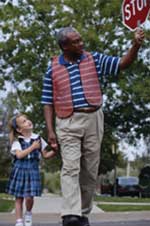
Eye health education and promotion programs are happening in communities across the country and in some U.S. territories. The National Eye Institute (NEI) recognizes the importance of strengthening the capacity of community-based organizations to expand existing eye health education programs and start new ones.
The Healthy Vision Community Awards (HVCA) Program of NEI provides up to $10,000 in seed money to nonprofit, community-based organizations to support grassroots eye health education efforts. NEI encourages you to help make vision a health priority in your community by applying for a 2009 award or encouraging others to apply. Nonprofit organizations including, but not limited to, community-based organizations and groups, minority-based organizations, schools, faith-based organizations, civic and fraternal groups, and local health departments and agencies may apply. Universities and university-affiliations, such as medical centers, are precluded from receiving an award directly, but are welcome to collaborate with community-based organizations.
Proposed projects must support the vision objectives in Healthy Vision 2010, which aim to improve the eye health of the Nation through prevention, early detection, treatment, and vision rehabilitation. Projects must focus on eye health education and promotion, be innovative, and have the potential for sustainability once funding ends.
The 2009 funding cycle is soon approaching. Mark your calendar with these important dates:
June 30, 2008—Applications become available
August 29, 2008—Postmark due date for receipt of application
January 2009—Winners are notified
To learn more about the HVCA Program and what funds can be used for, visit www.healthyvision2010.nei.nih.gov/news/hvca. You will also find a list of the 50 Healthy Vision Community Award winners for 2008.
To get additional ideas and to learn about other community-based eye health education programs in U.S. states and territories, visit the Healthy Vision Community Programs (HVCP) Database at /nehep//. NEI welcomes and encourages submissions to the database on all community-based eye health efforts. If you know about a program that should be included, visit the HVCP Database link and click on Submit a Program.
HRSA Unveils Free Online Health Literacy Training for Health Professionals
Health professionals in the United States and around the world are improving their patient communication skills with a new online tutorial. The course, developed by the U.S. Department of Health and Human Services’ Health Resources and Services Administration (HRSA), is called Unified Health Communication 101: Addressing Health Literacy, Cultural Competency, and Limited English Proficiency. Recently, the course was selected for an award from the National Association of Government Communicators.
The course was designed to help healthcare providers increase their knowledge of factors that affect communication with patients and to learn about their patients’ health literacy, culture, and language skills, and how each can influence a patient’s ability to communicate about health-related issues.
The course takes a holistic approach by bringing together health literacy, cultural competency, and language skills as they relate to English proficiency.
Health literacy is the degree to which individuals can obtain and understand basic health information needed to make appropriate health decisions.
Cultural competency reflects a provider’s knowledge of the health-related beliefs, attitudes, practices, and communication patterns of clients and their families to improve health outcomes.
Language skills address the degree of proficiency a patient has to read, write, speak, or understand English.
The program contains five modules that each take about one hour to complete. Module 1 provides an introduction to health communication. Other units address health literacy, cultural competency, and limited English proficiency. The final module is an exercise designed for participants to test their ability to interact effectively with patients.
The course is free and can be done at a user’s own pace. To date, continuing education credit for this course has been approved by the following:
- American Academy of Physician Assistants
- American Association for Health Education
- American Pharmacists Association
- National Committee for Quality Assurance
Since the website went live in November 2007, people from more than 10 countries have signed up for the course. HRSA reports that as of mid-March, over 1,500 people have registered for the course. More information, including registration instructions, is available at www.hrsa.gov/healthliteracy/training.htm. For additional information, contact Linda Johnston-Lloyd of the HRSA Center for Quality at Ljohnston-lloyd@hrsa.gov.
On the Road with NEI
![]()
The National Eye Institute (NEI) regularly exhibits at national meetings across the country. Exhibits provide an opportunity to share information and publications, promote NEI messages and resources, and strengthen links with partner organizations. Upcoming NEI exhibits are listed below. If you plan to attend any of these meetings, please stop by and say “hello”!
2008 CDC Diabetes Translation Conference
Wyndham Orlando Resort Hotel, Orlando, FL
May 5 to 8
NEI Booth No. 18
American College of Physicians Internal Medicine 2008
Washington, DC Convention Center
May 15 to 17
NEI Booth No. 2641
2008 National Council of La Raza Annual Conference
San Diego Convention Center
July 12 to 15
Association for Education and Rehabilitation (AER) of the Blind and Visually Impaired 2008
International Conference
Marriott Chicago Downtown, Chicago, IL
July 22 to 27
National Association of Community Health Representatives Education Conference
Riviera Hotel & Casino, Las Vegas, NV
July 28 to 31
Need help working with PDF files?

